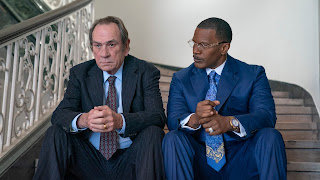Faith in Film, Week 4
As we continue our look at Stephen King, we take a look at another of his stories, the novel "The Green Mile." This one was also directed by Frank Darabont, who did our film last week, "The Mist." But the book began in an interesting fashion.
While you can get it as a full, feature-length novel now. It was original released as a serialized story. If you’ve seen the complete novel, you know that it has six different sections with subheadings. Those were originally released as six individual stories, all meant to be read together. The Green Mile was first published in six low-priced paperback volumes. The first, subtitled The Two Dead Girls was published on March 28, 1996, with new volumes following monthly until the final volume, Coffey on the Mile, was released on August 29, 1996. The novel was republished as a single paperback volume on May 5, 1997. On October 3, 2000, the book was published in its first hardcover edition.
At first Darabont was reluctant to adapt the novel into a film, as its setting was too similar to Shawshank, but quickly changed his mind after reading the novel. Hanks and Darabont first met at an Academy Award luncheon in 1994 and the two were both eager to work on a project together. King stated he envisioned Hanks in the role and was happy when Darabont mentioned his name.
Audiences and critics were happy, too. The Green Mile had a great Cinema Score, and grossed more than $280 million worldwide. It was also nominated for four Academy Awards, including Best Picture, Best Adapted Screenplay, Best Sound and Best Supporting Actor for Duncan. It didn’t win any awards, but it remains a favored and well received film now 20 years after its release. And that’s due in large part to the beautiful story that it tells.
There is a lot that is going on in The Green Mile. The book is more than 420 pages, and the movie spans about three hours. And it still doesn’t capture the whole depth of the story that’s in the novel. For those that have read the book, you’ll know there is a sequence and depth to the story that can’t be contained in the film. As much as I appreciated the film, I liked the book much more.
This is a story that mostly takes place in the 1930s, during the depression, on Death Row of a prison referred to as the Green Mile because of its flooring. It focuses on a group of guards, led by Paul Edgecomb (Hanks) who takes his job seriously and treats the prisoners entrusted to his care with a sense of dignity. That is an approach shared by most of the guards who work for him on the Mile, but not Percy Whitworth. We’ll come back to that in a minute.
As the film opens, the Mile gets a new resident in John Coffey, a mountain of a man accused of a terrible crime. Early on Paul begins to feel that what he sees of Coffey doesn’t fit the description of the man’s behavior and his crimes. And soon, when they are alone and Paul is suffering terribly from a bladder infection, he comes to see that Coffey has a gift. Learning of that gift, and seeing it applied a few times, takes Paul on a journey he reflects on the rest of his life.
But that's only part of what this story has to tell us about miracles and the state of the world, which we'll consider on Wednesday night.
Here's the discussion questions we'll consider Wednesday, too.
Discussion Questions:
1. Did this movie work for you, why or why not?
2. This story is one full of miracles and discussions of faith. Paul Edgecombe believes miracles are possible, and miracles come from God, and it drives his decisions. What did you think of that aspect?
3. The story has a hard view of humanity, the world and the idea of mercy. What did you think of that aspect of the story?




Comments
Post a Comment